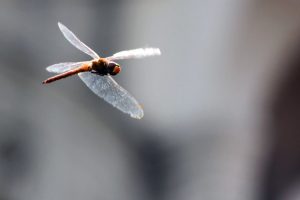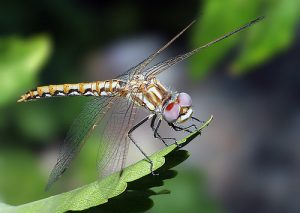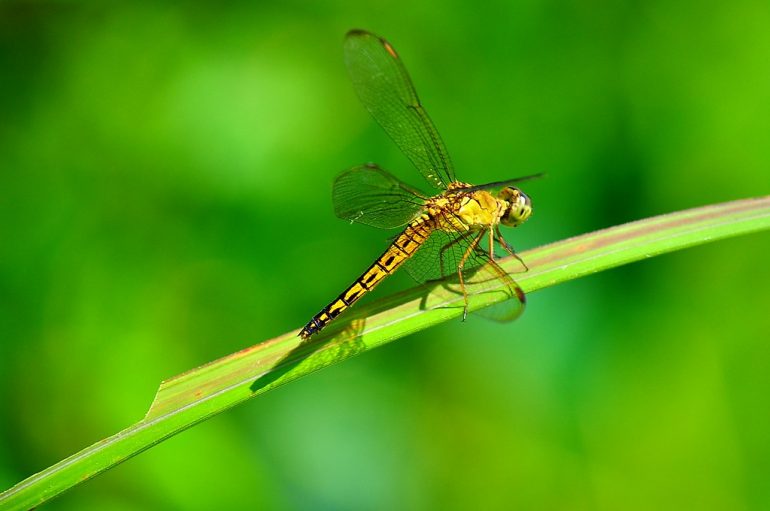If your friend bounced a single tennis ball towards you, you might find it easy to catch it. If they told you to focus and catch only one specific ball among a few, you might still succeed. What happens when there are fifty identical tennis balls bouncing every which way, and you must not only keep your eye on the correct one but also move to reach its unpredictable path before it flies past you? It might be more difficult to succeed. Dragonflies experience a similar case, though instead of chasing after tennis balls, they chase prey that makes abrupt changes in their path of movement. Dragonflies’ abilities to focus on the one prey and meet it at its unpredictable path, aided by physiological and neurological components, determine their survival.
Body dynamics and neurological processes contribute to dragonflies’ interception steering— their steering to meet their prey in its path— and contribute to their high hunting-success rate. An article published in 2014 used fruit flies as prey to study the way dragonflies’ psychological processes, such as their body positioning, may contribute to their success during hunting. However, a 2013 study concluded that, of the specific dragonfly species of its samples, different species of prey and distances between them and the predator may affect the dragonflies’ methods of pursuit. It is suspected that dragonflies assess their prey’s movements before pursuing the target, during which they predict the position of the prey before pursuit. While hunting, the dragonflies’ bodies seem to rotate purposefully. Researchers found that a hunting dragonfly would position its body axis to the direction of the prey’s movement at a specific angle. The rotation of the dragonfly’s body seemed to have increased the distance between the interception point of the target, or the point at which the dragonfly meets the prey at its path, and itself compared to the distance without rotation. However, the orientation of the dragonfly’s body with respect to the movement of its target, may make for faster speed and more accurate motion control as it chases after potentially-unpredictable prey. The dragonfly also consistently maintains the degree of its body axis at approximately 30º which, along with its alignment to the prey’s path, is its preferred placement to snatch its prey. This alignment also places it directly below its target and in its target’s blind spot. This allows them to capture their prey more easily, as the dragonfly would less likely be spotted by their prey. By positioning themselves in such a way, they would also only need to keep their alignment and close the vertical gap between predator and prey to reach the interception point.
However, body-axis positioning will not suffice on its own. The same 2014 study observed the role of head movements in hunting patterns of sample dragonflies. If the target were to suddenly change its path, the dragonfly may experience inefficiencies and larger movements to change its path too. Hence, any drastic changes in dragonflies’ body movement may be negated by the dragonflies’ head movements, making large and inefficient turns during flight quicker in response to their prey’s flight patterns. Depending on the movement of the prey, such head movements can either be predictive or reactive. When a particular prey follows a straight path at a relatively constant speed, dragonfly head movements are predictive. When chasing a prey that does change direction suddenly, dragonfly head movements are more reactive than predictive due to the sudden change of motion. Such head movements still negates any of the dragonfly’s drastic and time-consuming body motion as it follows its target. Their head movements keep the image of the prey clear even during abrupt movements.

Paired with dragonflies’ body dynamics are their neurological processes. The prey they hunt often travel in swarms. In order to avoid confusion and a decrease in hunting efficiency, dragonflies use selective attention and focus on a specific target while ignoring the rest. Their fovea, located in the upper part of their compound eyes, helps with selective focus and allows the dragonfly to adjust its motion to pursue its target. The specific neuron used in selective attention is the Centrifugal Small-Target Motion Detector 1 (CSTMD1), located in the optic nerve and midbrain. CSTMD1 allows the dragonfly to selectively focus on a small, dark target against a bright background (such as fruit flies or mosquitoes in daylight). The neuron’s function also demonstrates flexibility, as the dragonfly can still shift its selective focus to a different target, even mid-hunt, if a better opportunity arises. CSTMD1 also demonstrates “predictive gain modulation,” or the increased detection of small targets and awareness immediately in front of the target’s path of motion while inhibiting other areas of its visual field. The CSTMD1 neuron, in conjugation with other neurons, can predict the immediate future location of the dragonfly’s target, even if the target comes into extreme close distance with others in their swarm. For instance, imagine focusing on one tennis ball while it comes into direct or close contact with multiple identical balls. Without accurate fixation on the selected target, such close proximity to other objects would decrease tracking accuracy and capture success. The CSTMD1 neuron’s response to target position in dragonflies’ visual field could play a role in how the dragonfly aligns itself to its prey’s path of motion, preserving the retinal placement that encourages most CSTMD1 function. This strong selective attention may be an evolutionary advantage in dragonflies as they hunt prey that travel in swarms.
The combined physiological and neurological processes of dragonflies make them some of the most formidable and successful hunters in the insect world. The alignment of their body and head, highly acute eyesight and selective focus, and directional control allow it to chase after prey in the most efficient and stealthy way. Such fine-tuned abilities surpass those of many other predators in the animal kingdom, such as African wild dogs, cheetahs, lions, and wolves. With a 95% hunting success rate, they may be one of the most formidable predators in the world.

References:
- https://www.nature.com/articles/nature14045
- https://pubmed.ncbi.nlm.nih.gov/23784698/#:~:text=Our%20results%20show%20that%20dragonfly,velocity%20generally%20increases%20with%20size
- https://www.britannica.com/animal/Odonata/Form-and-function
- https://www.jneurosci.org/content/39/43/8497
- https://www.sciencedirect.com/science/article/pii/S0960982217302798#bib23
- https://pubmed.ncbi.nlm.nih.gov/31395677/
- https://www.discoverwildlife.com/animal-facts/mammals/hunting-success-rates-how-predators-compare/
- https://pubmed.ncbi.nlm.nih.gov/31395677/
- https://pubmed.ncbi.nlm.nih.gov/17487492/
- https://journals.biologists.com/jeb/article/222/17/jeb207316/223546/Properties-of-predictive-gain-modulation-in-a
- https://journals.biologists.com/jeb/article/210/18/3277/17040/Neural-mechanisms-underlying-target-detection-in-a
- https://ieeexplore.ieee.org/document/6146547
- https://www.sciencedirect.com/science/article/pii/S0960982217310874
- https://www.nature.com/articles/s41598-021-83559-5
- https://ieeexplore.ieee.org/stamp/stamp.jsp?tp=&arnumber=6146547
